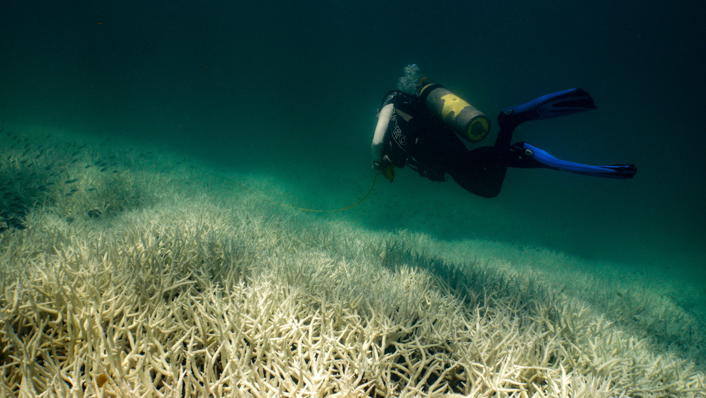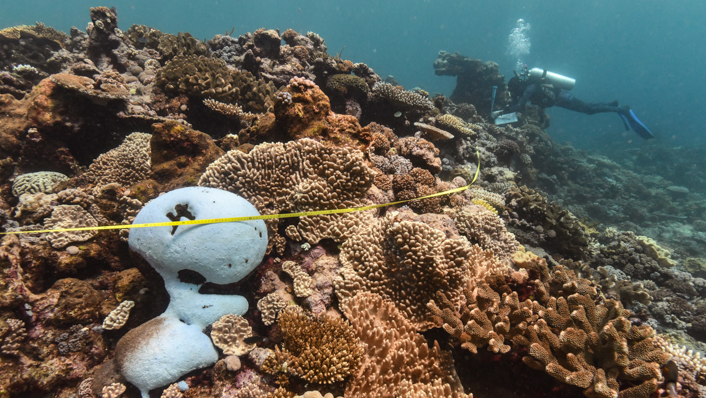The Australian Institute of Marine Science (AIMS) in collaboration with the Great Barrier Reef Marine Park Authority have observed extensive coral bleaching caused by elevated sea temperatures during aerial and in-water surveys of the Reef.
This information confirms that a mass coral bleaching event is taking place on the Great Barrier Reef which is the fifth such event since 2016.
The aerial surveys have so far covered almost two-thirds of the Great Barrier Reef Marine Park.

AIMS Senior Research Scientist Dr Neal Cantin, who led the aerial surveys, said observations had been collected from over 300 inshore, midshelf and offshore reefs, in the southern and central regions up to Cape Melville north of Cooktown.
"When bleaching becomes common across many sectors of the Great Barrier Reef, including both inshore and offshore reefs, it becomes a mass bleaching event," he said.
"As the Great Barrier Reef ecosystem is so large, the size of Italy, the heat stress across it isn't uniform. As a result, we are seeing differences between reefs with respect to the number of corals that are completely white. This pattern largely follows the pattern of accumulated heat stress seen over the past few months.
"Conditions over the next few weeks will determine the outcome.
"Until both the aerial and in-water surveys have been completed and the data analysed, we cannot predict the potential impacts that will follow this year's mass bleaching event.
"These surveys will continue to document the prevalence and severity of coral bleaching across a range of habitats and depths until the end of March. They will complete our full assessment of the spatial extent of coral bleaching into the remaining remote inshore and offshore regions of the Great Barrier Reef."
More aerial surveys of the offshore southern region, far northern region and the Torres Strait Islands will be completed when wind and weather conditions become more suitable.

Mass bleaching events in context
Mass bleaching events are a modern phenomena, caused by ocean warming due to climate change. Previous mass bleaching events on the Great Barrier Reef have occurred in 1998, 2002, 2016, 2017, 2020 and 2022. Prior to these years, there is no evidence of such widespread events in the Great Barrier Reef's 500-year coral record history.
AIMS Research Program Director Dr David Wachenfeld said that climate change has contributed to elevated sea surface temperatures on the Great Barrier Reef, driving the widespread bleaching event.
"We acknowledge this is distressing news for everyone who loves and depends on the Reef," he said.
"2023 was the hottest year on record globally and so far 2024 is exceeding those record temperatures in our global oceans.
"In the last northern hemisphere summer there was record breaking heat stress in the Caribbean and the Eastern Pacific, causing severe and widespread coral bleaching. This mass coral bleaching event on the Great Barrier Reef is part of a global pattern of extreme heat, caused by climate change," Dr Wachenfeld said.
"The Great Barrier Reef has seen increases in coral cover to high levels in recent years, indicating it is still a resilient system. But this resilience has its limits. While some areas have continued to gain coral cover even through other bleaching events, others have failed to recover to this extent.
"The differences between the reef communities and between coral types due to disturbances, especially coral bleaching, are important to understand.

"AIMS is currently focused on providing the science necessary to monitor and understand the effects of heat stress on coral reefs, the adaptation potential and recovery rates on reefs around Australia, and use this to guide management and future restoration efforts.
"Climate change remains the biggest threat to coral reefs globally. It causes more frequent and severe marine heatwaves, leading to shortened windows of recovery for corals from bleaching and other disturbances. Recent gains can be lost in a short amount of time, as recorded in our long-term monitoring of the system.
"But it is also important to note that mass coral bleaching events do not affect all reefs and all corals equally.
"The Great Barrier Reef experiences many different conditions across its 3000 reefs. This is why we need data from all our surveys before we can make an assessment of the severity and potential impacts of this mass bleaching event."
Dr Wachenfeld stressed that "to protect coral reefs like the Great Barrier Reef from climate change, we need strong global emissions reduction to stabilise temperatures, best practice management of local issues, and the research and development of interventions to help boost climate tolerance and resilience for coral reefs."
AIMS scientists and managers from the Reef Authority will apply data from the observations from both aerial and in-water surveys within the new bleaching impact framework developed in collaboration with the Reef Authority and James Cook University assess the extent, severity and prevalence of this coral bleaching event.
As well as monitoring the bleaching prevalence, AIMS science teams are currently in the water examining the effects of heat stress on corals along the length of the Reef. They are also seeking to identify heat tolerant corals within bleaching reef communities to investigate adaptation and support future restoration activities.
Feature image: Coral bleaching at Mackay Reef, northern Great Barrier Reef, February 2024. Image: AIMS | Grace Frank






